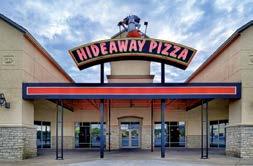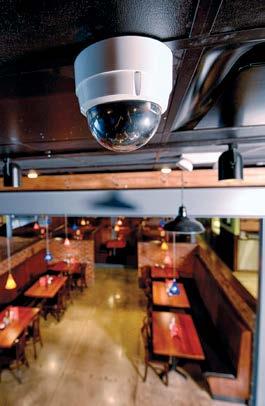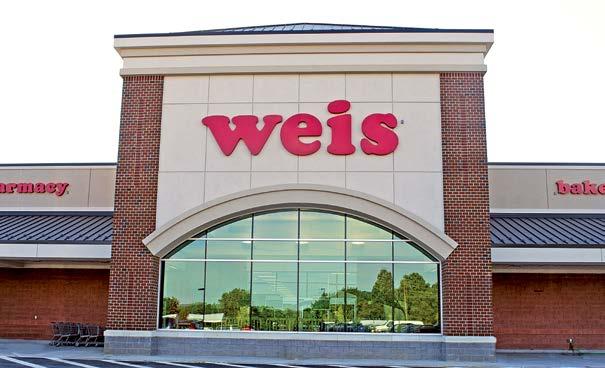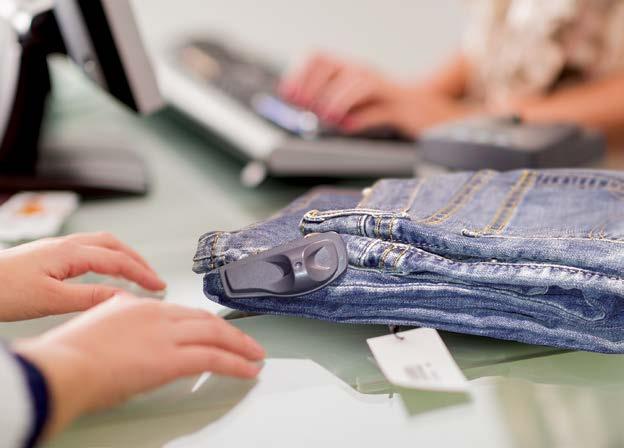
10 minute read
SOLUTIONS SHOWCASE
SOLUTIONS SHOWCASE MARCH NETWORKS
Pizza Chain Leverages March Networks Retail Video Solution for Operational Excellence
Some restaurateurs think of video surveillance strictly as a tool to investigate incidents of theft and other risks, such as slips and falls. But Hideaway Pizza, a twelve-restaurant chain based in Tulsa, Oklahoma, thinks of video surveillance more as a critical enabler of operational excellence. Deterring and minimizing losses due to theft impacts the bottom line, but the true success of a restaurant has a lot more to do with the performance of the kitchen and wait staff, their interaction with customers, and the quality of the food. With that in mind, Hideaway Pizza equips a typical restaurant with up to twenty-five surveillance cameras covering the front of the house, the kitchen, cash drawers, bar area, entrances, exits, and parking lot—“Pretty well every nook and cranny,” notes Tyson Smith, Hideaway Pizza’s IT director.
Using video surveillance as a management and training tool can definitely contribute to a restaurant’s success, but only to the extent that the video surveillance system itself is reliable and easy to use.
According to Smith, Hideaway Pizza had the right idea but was hampered by the deficiencies of its Windows-based technology.
Video wasn’t recorded during Windows OS updates, there was a limit to the number of users who could log on to view video at one time, and it was impossible to manage the recorders from a central location. Even more troublesome, “The systems would be down, and we wouldn’t know why,” says Smith, who experienced the same deficiencies while serving as an IT director at a previous employer.
“We deployed March Networks’ video surveillance systems there,” he notes. “It really helped to overcome the issues we had with Windows machines. When I joined Hideaway Pizza, they had the same issues, so I felt strongly that March Networks was the way to go once again.”
The company’s 8000 Series hybrid recorders had just been unveiled and were deemed to be a perfect fit.
“We’re deploying March Networks’ MegaPX WDR MiniDome cameras in our newest restaurants, and we’re replacing the recorders that are getting old and breaking down,” says Smith. “We have analog cameras in our older locations, so the hybrid recorder gives us a really good platform for both instances.”
The 8532 Hybrid NVRs accommodate up to 32 IP cameras, 32 analog cameras, or any combination of the two. It features up to 12 TB of onboard video storage and offers optional hard-disk mirroring for redundant storage.
Hideaway Pizza uses March Networks’ Visual Intelligence software suite and the powerful Enterprise Service Manager for remote management and resource optimization.


Store managers have access to video from their restaurants, regional managers have access to the locations for which they’re responsible, and executives have access to all of the restaurants. The system gets a lot of use.
“It’s like instant replay in sports,” says Smith. “If we can help our team members improve how they serve guests, it’s better for everyone.
“We can see the food being prepared and going up to the window, and we can see how long it sits there before it gets delivered to the table. If a customer complains that his food is cold, we can tell if the customer is correct. We can also investigate customer incidents such as slips and falls.”
Smith credits certified provider SageNet LLC for helping Hideaway Pizza with the transition to a more reliable video surveillance platform.“We’ve had great support along the way and have had no real issues. The systems are performing exceptionally well.”
March Networks® is a leading provider of intelligent IP video solutions used by retailers worldwide to enhance security, improve store operations, and reduce shrink significantly. The company’s retail solutions include centralized video management, high-performance hybrid NVRs, IP cameras, video analytics, and powerful software applications purpose-built to speed retail LP investigations and strengthen case evidence. www.marchnetworks.com
SOLUTIONS SHOWCASE INSTAKEY SECURITY SYSTEMS
Weis Markets Focuses on Key Control to Enhance Security

For more than 100 years, Weis Markets has provided high-quality groceries in Pennsylvania, New Jersey, New York, West Virginia, and Maryland. With more than 160 stores, two distribution centers, a dairy plant, and a meat-packaging facility, Weis Markets’ asset protection team faces new challenges and opportunities every day. An important challenge facing Michael Limauro, Weis Markets’ vice president of asset protection, when he arrived at the company nearly three years ago, was key control. At the time the grocery stores did not have a standardized key and core access system, prompting him to research new security solutions. After speaking to Michael Limauro a fellow asset protection colleague from another grocery chain, Limauro was introduced to InstaKey Security Systems, which offers a key control program specifically designed to meet grocery stores’ security needs.
Saving Time and Money
One of the identified areas of improvement was rekeying due to lost keys or management turnover. The AP team saw these expenses consistently costing the company thousands of dollars per incident.
“The fact that InstaKey locks can be rekeyed up to nine times without actually having to re-core a building was a big deal to us,” Limauro explained. “Typically, in our business if a manager loses a key, we have to re-core the entire building, and that can cost between $2,000 and $3,000.”
“With InstaKey, instead of pulling the cores out, we can rekey with a quick turn of a key in the lock, and then we simply reassign the new keys,” he continued. “That simple process renders the old keys useless, and we can rekey an entire site now for less than $50.”
This instant rekey process eliminates the need for additional cores or waiting for a locksmith to replace the affected locks.
Improving Key Holder’s Accountability
As important as the time and money savings are, it’s also essential that a key control program actually results in managed security improvements.
Unlike some other key systems, Instakey Security Systems tracks each key online from the moment it’s manufactured through key-holder acceptance. This lets the customer know precisely how many keys are out there, where the keys have been, and who is holding them. These restricted keys can’t be manufactured by a third party like those of other suppliers.
In addition, this assignment process promotes accountability and key compliance among staff members. “We generate key receipts electronically every time we administer serialized keys to new associates,” said Limauro. “So, basically, the key receipts are the written acknowledgement that they received their specific keys and that they understand the rules of controlling those keys. This procedure creates a perception of control, where they see the keys are being monitored, we’ve set expectations, and we’re going to hold them accountable for controlling their keys.”
Instakey Security Systems’ program has saved Weis Markets’ asset protection and store personnel time and money while improving their facilities’ security. And more than that, the key control program is easy to use and has been well-received by the staff.
“Our store managers went from carrying large key rings with a dozen or more keys on them to carrying two keys,” said Limauro. “From the store managers’ standpoints, it was so much more efficient and easier to control for them, so they absolutely love it.”
In order to capitalize on the information InstaKey Security Systems manages, Limauro has now included a key control audit component to Weis Markets’ AP mobile field app. These audits that can be conducted with just the touch of a button on a tablet are an easy and impactful way to get hard data while on site helping to reinforce the company’s level of control.
The partnership between Instakey Security Systems and Weis Markets has produced a cost-effective, user-friendly key control program that has spurred measurable improvements in grocery store security.
For more information about InstaKey Security Systems, call 800-316-5397 x125 or email sales@instakey.com.

SOLUTIONS SHOWCASE TYCO RETAIL SOLUTIONS
The Next 50 Years The Evolution of Source Tagging and RFID
By Nancy Chisholm

Remember when phones were used only for making calls? They were corded, clunky, and only worked with dedicated lines. If you wanted to take photo or a video, you needed yet another device, and if you wanted both to capture images and record video, then you needed two! Fast forward to today when phones are used for so much more than making calls. A smartphone is an all-in-one device that combines voice, data service, and even a camera for stills and video all in one neat package. Electronic article surveillance (EAS) hard tags have undergone a similar evolution moving from cumbersome “dumb” tags to a multipurpose application. In the early days, hard tags were dumb, clunky annoyances attached to only a certain category of garments, much the same way the first cell phones were clunky, impractical, and anything but “smart.” Today, however, EAS hard tags are sleek, available for most product categories, and serve as the underpinning to every store operations system. As any retailer can attest, effective and efficient operations are more important than ever as customers demand excellence at every interaction and competitors wait in the wings if customers’ needs cannot be met.
When it comes to the in-store experience, today’s consumers demand attentive associates, in-stock items, and a fast, easy checkout process. Subsequently, retailers need their employees to be not only motivated to help customers but also empowered with more time to service those shoppers and minimize the superfluous tasks on the selling floor. Source tagging facilitates many of these operational synergies in the value chain for today’s retailer, and adding RFID provides the insight needed to make it a reality.
New hard-tag recirculation allows retailers to take advantage of the benefits of source tagging while still maintaining the safety and security of a hard-tag format—a necessary visual deterrent. In addition to the traditional benefits of source tagging—reduction in shrink and labor expenses, increased sales with floor-ready merchandise— hard-tag recirculation can also serve as an important bridge to RFID-based solutions for loss prevention and store
performance applications. With just one dual acousto-magnetic (AM)/RFID hard tag applied at the source, retailers can extend the benefits of traditional loss prevention to store performance initiatives. That combination of insight and action is a powerful force in today’s hyper-competitive retail environment. For example, by leveraging hard tags enabled with dual AM and RFID technology, retailers can turn that traditional source tag into a smarter tag and gain better visibility into shrink. The dual-technology approach allows retailers to track shrink loss at the item level and replenish those stolen items in a timelier manner to avoid out-of-stock conditions. It can also provide better insight into where, what, and when items were stolen and further differentiate between actual store shrink Nancy Chisholm Vice President & and other forms of inventory distortion. And perhaps most importantly, it can enable preventative measures thanks to General Manager Tyco Retail Solutions predictive-analytics capabilities. This approach also bolsters inventory visibility programs. Beyond better planning and allocation for inventory at the item level, this level of detail can reduce needless markdowns while increasing overall sales and customer satisfaction. For nearly 50 years, the hard tag has been a critical, trusted component of an EAS system. It is hard to imagine a retail store without them. Much the way our landline phones evolved into smartphones, dual-technology tags and source-tagging programs will prove to be the pathway for the future of smarter, more responsive retailers and happy, satisfied customers.
Tyco’s Sensormatic source-tagging program improves product protection and operational efficiency for increased customer engagement.






